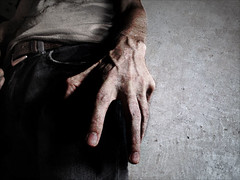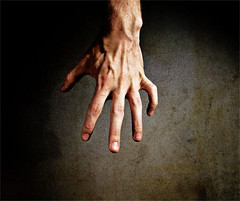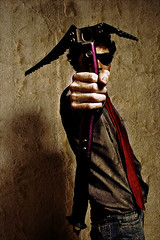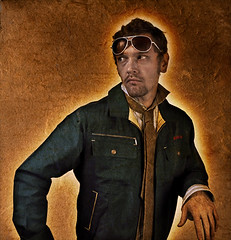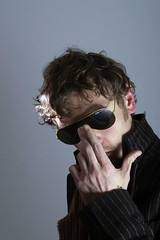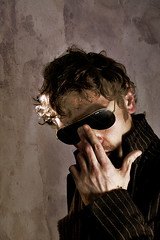There are few things which I view with a need-it-now mentality, in particular when it comes to education. It might suck to learn long division as a disgruntled youth, but it pays dividends later in life when you can calculate things fifty times faster than someone who needs a calculator.
Similarly, I didn’t buy the Joey L DVD thinking it would change my Photoshop skills overnight, but rather, over time it would either have a positive, or absent affect. The purpose of this extended After-the-Honeymoon review is to look at how the material from the Joey L DVD affected my photoshop and photography capabilities – after the initial joy of buying another digital imaging product had worn off.
First: Why Buy a DVD Tutorial?
The main criticism of the Joey L DVD Tutorial in various internet circles is that it’s overpriced, and doesn’t show anything that can’t be learned on the internet, either for free, or via modest monetary costs. So why buy it?
It’s true, there are countless opportunities to learn Photoshop and Photography on the web. Sites like Scott Kelby, Layers Magazine, Photoshop User TV, Dr. Brown, and a number of random totally free videos and written tutorials (often with sample files) are sitting there in virtual space, begging to be viewed. There’s also libraries of books on-hand dealing with every aspect of Photoshop.
I also know from experience that a number of the tutorials are little more than simple near-pointless tips on using curves, the healing brush, and converting to Black and White. Not all of course, the paid ones have more real value and there are many gems at Layers Magazine. However, my main experience is that many almost universally use bland uninspiring images for their examples, and often times it feels like I’m watching a copy of a copy of a copy. I was looking for something more original to supplement my Photoshop education.
One main draw of the Joey L DVD tutorial is that Joey Lawrence is an actual working photographer. A dynamic beacon of creativity in an industry of imitators. The draw of learning from an active Pro is unique for me, as I often have the feeling that too many tutorials are done by people who realized it was more profitable to teach Photoshop instead of being a photographer. This is probably a pessimistic view, and there’s really nothing wrong with that business model, I encourage folks to make money in any legal fashion they wish, and teaching is one of the noblest professions. Still, I get my science education from world class-researchers. Why skimp on my Photoshop education?
A tutorial like the Joey L DVD instantly makes me think of photography workshops. Workshops are popular from a few perspectives; when you get to the point as a photographer that you want to expand your creative consciousness or skills in a certain areas, or you travel to some distant hard-to-organize location. Workshops are generally considered to be money-well-spent, and in general I would never spend money on a workshop because many just seem like an excuse for people with too much money to pay someone to tell them to use their camera equipment. There are exceptions, if David Hobby or Don Giannati flew into Zurich for a Strobist or Lighting Essentials workshop, I’d probably be there to welcome them at the airport. Basically, I wanted a Photoshop tutorial, and the Joey L DVD seemed like a good fit.
Another main criticism is that Joey doesn’t teach good Photoshop technique. From a technical stand-point I’d say this is true – but if I was technically a Photoshop whiz, I wouldn’t have bought the Tutorial in the first place. The Joey L tutorial is primarily about using destructive editing techniques and just doing what "seems" right for the image – you know, to make it look good. I don’t really think this is a bad thing. This is what artistic expression is all about, if you stick to rigid guidelines in books and always listen to your teachers, you’ll always be one step behind your peers and more or less copying from the old Master’s.
If you copy what Joey does point-for-point, you’re not learning anything that a monkey couldn’t learn (yes, it could take a generation or two of breeding and genetic engineering). Anytime you’re confronted with a large, intimidating construct like biomechanics, quantum physics or Photoshop, playing around isn’t such a bad thing – and should be encouraged. "Playing around" has brought more ground breaking discoveries than I care to list, including penicillin and bubble wrap. Playing in Photoshop is an important lesson I’ve taken away from the tutorial, which is also how Dave Hill developed his legendary style that so many geeks try to achieve. This doesn’t mean I use the techniques Mr. Lawrence has described in his tutorial. I do Photoshop with my own workflow and so should you. But it’s not bad to learn from someone who isn’t using Adobe standard practices.
Ah, But the Cost
The Joey L DVD is not cheap, but education is what the student makes of it more so than what the teacher teaches. This is contrary to many philosophies of modern pedagogy, but after going through three engineering degrees and a few semesters as a teaching assistant, I feel comfortable saying that a motivated student will learn no matter how dimwitted the professor may be. Ahhh, but inspiration from a teacher, is sometimes priceless. The Joey L DVD was inspiring for me, and that is hard to put a dollar sign on. But it might not be for other pupils.
Draw Like the Maple Tree Young Grasshopper
I feel like the DVD has helped open up the horizons of Photoshop. This doesn’t mean that now I think that every photo needs to emulate Dave Hill and Joey Lawrence, it just means that my mind is more open to what I can do with the raw image – and the DVD Tutorial had a part in that.
I love to draw and do images on paper, but I’ve generally felt constrained in Photoshop, "Hmmmm, I should make layers with correct names and make sure I can go back and change everything." So, again one of the important lessons from the Joey L DVD is that a desire to play in Photoshop is essential, the program is a tool, not a defined process. My Photoshop skills are getting more fluid and playful, which opens up more creative directions in photo manipulation – and hence visual expression.
Was the Joey L Tutorial a good buy?
After 4 months, I’m still comfortable with the amount of money I threw down for the Joey L DVD. I come back to it and replay a lesson here and there when I need to, thinking back to the techniques, imagining how to use and create them differently, and often also disregarding them and doing something different.
I like being able to replay different lessons quickly, and then go back to other projects – something you can’t do with a workshop (unless they include a DVD). I’ll probably never buy another DVD like this again (ok, maybe one), the exception being the forthcoming Strobist DVDs or the offerings from Lighting Essentials.
Why not go crazy buying more DVDs? Because I’ve hit the point where all the other fine points of Photoshop can be easily found or discovered, maybe I didn’t need to buy the Joey L DVD to get to this point, but that’s the way I’ve arrived here, and I don’t regret the path I’ve taken.
Brass Tacks
Here’s the thing, with Photoshop I was looking for a spark, something to open the flood gates and broaden my horizons on this subject of digital post-processing. The Joey L Tutorial DVD did that – exactly that – I see images in layers and masks and color shifts and shadowed hues now. When I look at setting up a shot, I think about the post-processing, the way the lighting will define how the image can be manipulated later. This isn’t a certain style, it’s an addition to my digital visualization abilities – the same as visualizing a wide angle effect before taking a picture. The horizons for communicating a certain message have now been expanded.
Could the Joey L Tutorial DVD have been done better? The crazy thing about the Joey L Tutorial DVD is that it could have been one of the most fantastic photography-centered Photoshop learning tools ever created – if it had been created with an eye towards integrating the lighting and photoshop techniques. However, it doesn’t take long to see for yourself which type of images "work" and which ones "don’t" based on their lighting. No Photoshop action can "fix" images which don’t have the right lighting to start with. That’s the shortcoming of the Joey L DVD, the lighting-processing connection is mostly missing. However, playing around with different images and the Joey L actions will quickly reveal how lighting affects the post-processing.
Here’s an example, both of the images shown below were processed using the Joey L Signature Action, and should be slightly representative of how this technique works. It’s pretty obvious how the first image doesn’t really look all that great. It’s flat and desaturated, and more or less boring. This is because the face and torso are turned away from the light source, and all we have is definition of the jacket. However, the second image is better-lit, and renders the deep-grudge shadows much better than the first one. Once you see which type of images and lighting combinations work it’s easy to draw up in your mind how to design shots specifically for this type of deep-shadow processing.
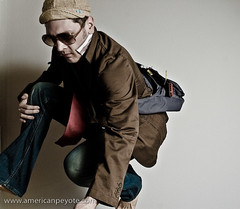 |
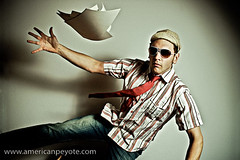 |
| Poor lighting, only shadow and definition in the jacket | Better lighting, good shadow definition of the arms, torso, and face. |
Monkey See Monkey Do?
There is a pervading attitude from many dark corners of the web that if you buy his DVD to learn from someone like Joey Lawrence, you’re trying to adopt or steal his look/style instead of developing your own. If such an attitude existed in the scientific research world, we’d still be riding horses and the telegraph would probably be 200 years from being invented. In general everything has been done before. There are very few truly new things. There was Dragan, people copied him by creating Photoshop actions, Joey Lawrence no doubt learned from these influences, and developed his own style. He made a DVD, I bought it, and here we are. That’s how progress and the evolution of style sometimes works in the digital imaging world.
As you move through life you learn things – and the knowledge you retain becomes tools which you can use to do other things: build bridges, take pictures, climb mountains, relax on a beach. The real mistake is not learning as much as you can and using those tools as desired. I didn’t set out to imitate Joey Lawrence, or to create iconic art that will stand the test of time. But if that iconic art thing happens, well – cool.
The Joey L Tutorial DVD is just an addition to my photography digital image making toolset, what comes next no one knows. Should you buy the Joey L DVD Tutorial, or that Canon 85 mm lens or that Nikon D300? Will a set of Profoto strobes make you a better photographer? Figure out what you "need" to accomplish what you’re seeking to accomplish – acquire those tools, and then go write your book, develop your look, live your life, whatever.
No one single piece of knowledge or equipment will improve your skills in life unless you’re motivated to push yourself to the next level, but once you know how things work…well, maybe I’m working on my own tutorial DVD…
